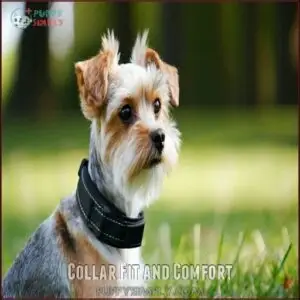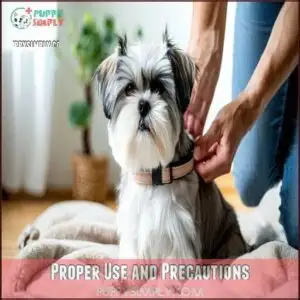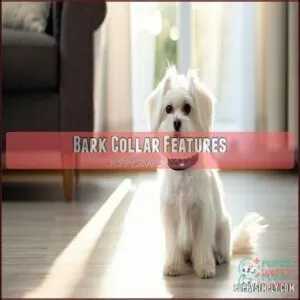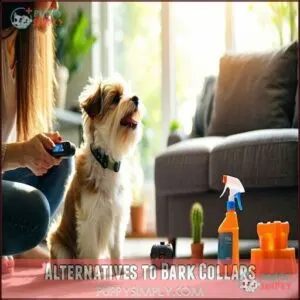This site is supported by our readers. We may earn a commission, at no cost to you, if you purchase through links.

Look for adjustable sensitivity levels and lightweight construction—your tiny teammate shouldn’t feel like they’re carrying a brick!
Vibration or tone options are gentler alternatives to static correction for pups under 15 pounds.
The PetSafe Small Dog Collar and DogRook Rechargeable No Shock model consistently earn top marks for comfort and effectiveness.
Always introduce the collar gradually and never leave it on for more than 8-10 hours.
Remember, these tools work best alongside training—the right collar is just one piece of your peaceful home puzzle.
Table Of Contents
- Key Takeaways
- Choosing Best Bark Collar
- Bark Collar Safety Concerns
- Top 9 Bark Collars
- 1. SportDOG NoBark 10 Rechargeable Bark Collar
- 2. PATPET Dog Training Collar Remote
- 3. Rechargeable Anti Bark Collar for Dogs
- 4. Rechargeable Shockless Bark Collar for Small Dogs
- 5. Small Dog Training Collar With Remote
- 6. PetSafe Remote Dog Training Collar
- 7. Garmin BarkLimiter Deluxe Dog Training Collar
- 8. Anti Bark Dog Training Collar
- 9. Rechargeable Smart Dog Bark Collar
- Effective Training Techniques
- Bark Collar Features
- Small Dog Breeds Considerations
- Ensuring Safe Use
- Alternatives to Bark Collars
- Frequently Asked Questions (FAQs)
- What is the best Barking collar for small dogs?
- What is a bark collar?
- How effective is a dog bark collar?
- Are Authen Bark collars safe for small dogs?
- How big is a small dog bark collar?
- Does the PetSafe bark collar fit a small dog?
- Do bark collars work on small dogs?
- What do vets recommend to stop dogs from barking?
- What is the best device to stop small dogs barking?
- Do vets recommend anti bark collars?
- Conclusion
Key Takeaways
- Look for lightweight, adjustable collars with gentle correction options like vibration or sound to ensure your small dog’s comfort and safety.
- Start with the lowest sensitivity setting, gradually adjust as needed, and monitor your dog’s reaction to prevent unnecessary stress.
- Pair the collar with positive reinforcement, rewarding your dog for quiet behavior to encourage long-term habit changes.
- Avoid static shock collars unless as a last resort, focusing instead on humane options like citronella spray or ultrasonic devices.
Choosing Best Bark Collar
When choosing the best bark collar for your small dog, focus on their safety, comfort, and unique needs.
Look for collars with adjustable settings, a snug fit, and gentle correction options to guarantee effective and stress-free training.
Correction Type Considerations
What’s the best way to find a bark collar that’s both effective and safe for your small dog? It’s all about the correction type.
Not all dogs react the same way, so choosing the right method can make training smoother. Here are four popular options:
- Vibration bark collars: These deliver gentle buzzes, perfect for sensitive pups. It’s a nudge, not a shock—great for first-time users!
- Ultrasonic alternatives: These collars emit a high-pitched sound dogs hear, but you won’t. It’s subtle yet effective for noise-sensitive breeds.
- Citronella bark collars: Sprays a harmless mist that’s safe for tiny pups, though some find the scent pesky.
- Shock collar risks: Use static correction only as a last resort for stubborn barkers, ensuring progressive correction to stay humane.
Many owners find a suitable option through a vibration collar purchase.
Intensity Adjustability Importance
When picking a small dog bark collar, intensity adjustability makes a huge difference.
No one wants their tiny companion overwhelmed by corrections that feel too harsh. Always opt for adjustable sensitivity, starting with the lowest setting to fit your dog’s unique temperament and avoiding overcorrection.
Considering different models, it’s useful to know that some offer varying stimulation levels for customized training.
| Here’s a handy guide: | Setting | Best For |
|---|---|---|
| Low (1-3) | Nervous or sensitive dogs | |
| Medium (4-6) | Adaptable personalities | |
| High (7-10) | Persistently stubborn pups |
Think of it as matchmaking—small dogs benefit from gradual increases and customized correction matched to breed sensitivity.
Collar Fit and Comfort
A comfortable fit is the heart of a small dog bark collar that works. Start by measuring your pup’s neck for proper sizing—too loose won’t work, too tight causes neck chafing or skin irritation.
Lightweight, soft straps with adjustable bark collar features guarantee comfort and prevent irritation during daily wear. Look for materials that won’t rub or snag.
- Allow space for two fingers under the collar
- Opt for breathable materials
- Prioritize weight distribution
- Confirm bark detection aligns properly
Bark Collar Safety Concerns
In the case of bark collars, your dog’s safety should always come first, especially for small breeds.
Using the collar correctly, like adjusting the settings and monitoring your pup’s reaction, can prevent discomfort or unnecessary stress.
Potential Risks for Small Dogs
Choosing a small dog bark collar means being mindful of their unique needs and potential risks.
With their tiny necks, poor fit can cause neck irritation or excessive pressure, leading to discomfort or even injury. Anxiety triggers are another concern, as intense corrections like static stimulation can overwhelm sensitive breeds, causing stress or fear-based behaviors.
Shock collars, while effective for some dogs, might feel too harsh for small breeds, turning training into trauma. For a safe bark collar option, look for lightweight, humane designs that prioritize gentle corrections such as vibration or sound.
Remember, your pup’s comfort and safety come first—small bodies deserve big care!
Proper Use and Precautions
Small dogs have specific needs regarding bark collars, making proper use key to safety and effectiveness. Always start with a gradual introduction to the collar at the lowest setting, giving your pup time to feel comfortable.
A well-fitted collar should allow you to slip two fingers between it and their neck. For a humane bark collar, avoid harsh corrections—gentle guidance works best.
Keep use limited to 8 hours a day to prevent skin irritation, and take it off during play or sleep. Check their neck daily for redness or discomfort.
Also, supervise your pup when using a small dog bark collar.
- Pro Tip: Consult your vet before starting any training program for extra peace of mind.
Monitoring Dog Behavior
Keeping an eye on your pup’s behavior is key to getting the most out of a small dog bark collar. These devices aren’t “set it and forget it” tools, so your attention matters.
By observing barking frequency, trigger identification, and overall behavioral changes, you’ll confirm the collar is helping—not stressing—your dog. The best bark collar works as part of a broader dog barking solution.
If corrections aren’t effective, switch modes or tweak settings. Training effectiveness relies on your involvement—and don’t fret, most small dogs adapt quickly with your support!
Here’s a quick guide:
| What to Watch | Signs to Note | What to Do |
|---|---|---|
| Barking Frequency | Gradual decrease | Keep sensitivity steady |
| Trigger Identification | Specific sounds/events | Remove or reduce stimuli |
| Behavioral Changes | Signs of stress (hiding, shaking) | Pause collar use |
Top 9 Bark Collars
Finding the right bark collar for your small dog can feel overwhelming, but we’re here to help with the best options for 2025.
Each collar on this list balances safety, comfort, and effectiveness to help you tackle excessive barking with confidence.
1. SportDOG NoBark 10 Rechargeable Bark Collar
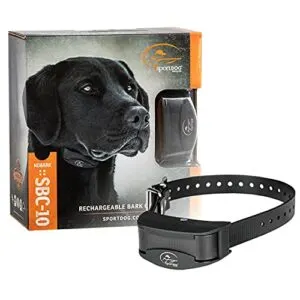
In the context of training stubborn barkers, the SportDOG NoBark 10 Rechargeable Bark Collar is a game-changer.
This collar uses Silent Partner Technology to detect and learn your dog’s unique bark, keeping random sounds from triggering corrections—because who wants their pup punished for barking at the neighbor’s lawnmower?
With two training modes, you’ve got flexibility. Progressive Correction gradually ramps up intensity if barking continues, while User Select lets you manually adjust the static level (10 options!) for your dog’s personality.
Designed for small dogs 8 pounds and up, it fits necks between 5" and 22".
Waterproof up to 25 feet (thanks to DryTek) and sturdy for outdoor adventures, it’s got you covered rain or shine. Plus, the rechargeable battery lasts 200 hours, and the built-in safety shutoff stops corrections after 80 seconds—keeping training both effective and humane.
Best For: Stubborn barkers or dogs needing tailored training with adjustable intensity and reliable correction technology.
- Silent Partner Technology ensures accurate bark detection and avoids false corrections.
- Two training modes with 10 levels of static stimulation for customization.
- Waterproof and durable with a 200-hour rechargeable battery.
- No vibrate or tone option offered as an alternative to static stimulation.
- Some users report inconsistent performance or defective units.
- Collar attachment and charger seating may require extra care.
2. PATPET Dog Training Collar Remote
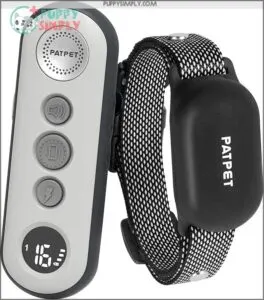
The PATPET Dog Training Collar Remote is a game-changer for small dog owners.
With a 3000-foot range, you’re in control whether your pup’s roaming the backyard or the park.
Its adjustable nylon collar fits dogs 8-100 lbs, making it a snug choice for small dogs.
Choose from three modes—beep, vibration, or static (1-16 levels)—to tailor training gently.
Plus, it’s IPX7 waterproof for rainy day adventures.
A 2-hour quick charge powers 40-60 days, ensuring training stays on track effortlessly.
Best For: Small, medium, and large dog owners who need a versatile, waterproof training collar with multiple training modes and long battery life.
- Long-range remote control up to 3000 feet.
- 2-hour quick charge with 40-60 days of battery life.
- Adjustable collar fits a wide range of dog sizes.
- Occasional issues with shock functionality and remote design.
- Mixed durability and reliability experiences among users.
- Limited effectiveness for certain dogs, requiring consistent use.
3. Rechargeable Anti Bark Collar for Dogs
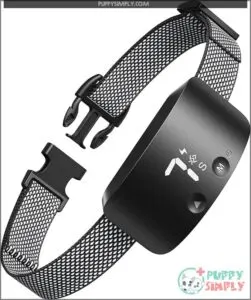
The NBJU Rechargeable Anti Bark Collar is a game-changer for calming excessive barking.
With three modes—beep, vibration, and shock—it adapts to your dog’s personality using seven adjustable sensitivity levels.
Its upgraded sensor detects barks in just 0.1 seconds, ignoring background noise.
Fully waterproof (IP67-rated), it handles rain or mud like a champ.
A quick 30-minute charge lasts up to 15 days, and its adjustable strap fits dogs from 8-120 pounds.
Safety features include correction pauses and silicone sleeves to protect your pup’s skin, ensuring a safe and effective training experience with the rechargeable collar.
Best For: Dog owners looking for a customizable, safe, and effective bark collar for dogs of any size, particularly those wanting quick results and long battery life.
- Offers three training modes with seven adjustable sensitivity levels.
- IP67 waterproof design suitable for all-weather use.
- Quick 30-minute charge lasts up to 15 days.
- Mixed durability feedback with some units failing after a few months.
- Silicone sleeves may come loose or be missing.
- Buttons and sensitivity settings can be tricky in noisy environments.
4. Rechargeable Shockless Bark Collar for Small Dogs
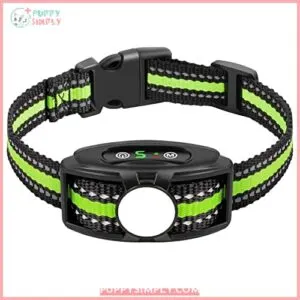
For little dogs with big attitudes, a rechargeable shockless bark collar offers a gentler solution to curb barking.
It uses beeps and vibrations suited to your dog’s size (5–15 pounds) and personality, ensuring it’s effective without being overwhelming.
Smart detection tech avoids false triggers, focusing solely on your pup’s bark.
Rain won’t ruin the day either, thanks to its waterproof design and reflective belt for safer strolls.
Its long-lasting battery means less charging and more peaceful days ahead—behavior improves fast with this effective solution.
Best For: Owners of small dogs (5–15 lbs) seeking a gentle and humane way to reduce excessive barking.
- Smart bark detection avoids false triggers from external noises.
- Waterproof and lightweight design ensures durability and comfort for your dog.
- Rechargeable battery with long life reduces the need for constant charging.
- May not work for all dogs, especially those larger than 15 pounds despite adjustable features.
- Requires consistent use and training for the desired results.
- Some dogs may take longer to adjust to vibration-based correction.
5. Small Dog Training Collar With Remote
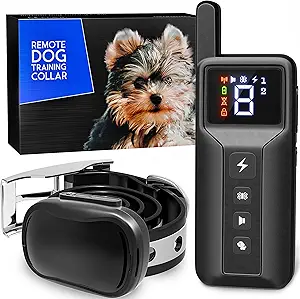
If your tiny dog’s barking feels like a full-time job, the Small Dog Training Collar with Remote may save your sanity.
Designed for pups over 5 pounds, it fits snugly with an adjustable 8–26" strap.
With a 1000-foot range, you’ll have control even at a distance.
Choose from three modes—sound, vibration, or shock—to match your pup’s temperament.
Its lightweight, waterproof design guarantees comfort in any weather, and the battery lasts a week.
Most owners find success using just the gentle vibration mode!
Best For: Owners of small dogs over 5 pounds looking for an effective and humane training solution with sound and vibration modes.
- Adjustable fit for small dogs with a lightweight, waterproof design.
- Provides a 1000-foot range for outdoor training.
- Long-lasting battery that only needs weekly charging.
- Shock mode may be too intense for very small dogs.
- Some users report durability issues and malfunctions.
- Electronic component may feel bulky for the smallest dogs.
6. PetSafe Remote Dog Training Collar
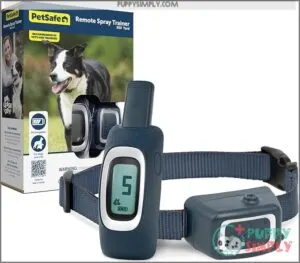
The PetSafe Remote Dog Training Collar is a smart choice for small dog owners who value gentle and effective training.
With three humane correction options—tone, vibration, and spray—you can easily tailor the training to suit your dog’s temperament. Whether your pup needs a gentle reminder with a beep or a quick citronella spray, this collar has you covered.
Its 300-yard range gives you the freedom to train indoors, in the yard, or at the park. Plus, the waterproof design means rainy days won’t interrupt your progress.
The rechargeable battery offers up to 40 hours of use, so you won’t be stuck constantly plugging it in.
Every collar includes both unscented and citronella spray cartridges, letting you find what works best for your pup. Veterinarians often recommend this collar for its effectiveness without causing stress. It’s practical, pet-friendly, and perfect for tackling those stubborn barking habits.
Best For: Small dog owners looking for humane and customizable training solutions.
- Remote buttons may feel awkward to use.
- Limited spray cartridge compatibility requiring specific refills.
- Mixed reviews on battery performance with frequent charging reported by some users.
- Offers tone, vibration, and spray options for gentle training.
- 300-yard range works for indoor and outdoor use.
- Waterproof and rechargeable with up to 40 hours of battery life.
7. Garmin BarkLimiter Deluxe Dog Training Collar
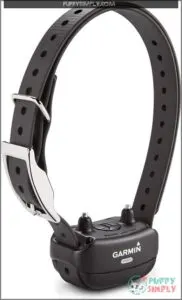
If you’re looking for a bark collar that balances precision and effectiveness, the Garmin BarkLimiter Deluxe might be your best bet.
At a featherlight 2.5 ounces, this collar is as comfortable as it’s clever, especially for small to medium dogs.
Its standout Perfect Bark technology guarantees it only responds to your dog’s bark—no more false corrections caused by background noises.
With three training modes (vibration, tone, and static), plus 18 adjustable intensity levels, you’ve got plenty of options to tailor the training to your pup’s temperament.
One handy feature is the AutoRise mode, which adjusts correction levels automatically as your dog learns, making it easier for you to stay consistent.
The Bark Odometer tracks corrections, so you’ll know exactly how training is progressing.
Rain or shine, this waterproof collar is ready for outdoor play.
Just remember to give your dog breaks to keep training stress-free and safe.
Best For: Owners of small to medium dogs looking for a precise and adjustable bark control collar with advanced features.
- Mixed results depending on dog breed and temperament.
- Not suitable for 24/7 use, requiring careful monitoring.
- App functionality may be unreliable.
- Lightweight and comfortable design suitable for extended wear.
- AutoRise mode for automatic adjustment of correction levels.
- Waterproof and durable for all-weather use.
8. Anti Bark Dog Training Collar
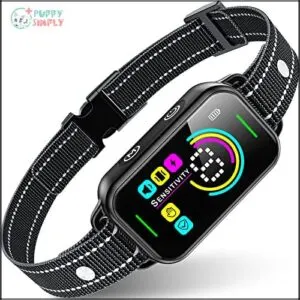
For small dogs with big voices, the Anti Bark Dog Training Collar is a smart, worry-free option.
Its automatic safety-off feature kicks in after six triggers, ensuring your pup’s protection.
You’ll appreciate the four customizable training modes (beep, vibration, combined, and shock) and eight adjustable sensitivity levels to avoid false alarms.
Built to handle all weather with its waterproof design, its rechargeable battery lasts up to 15 days.
Comfortable and snug, it fits dogs 8-120 lbs with necks 6-27 inches.
Best For: Dog owners seeking an effective, versatile, and safe training collar for small to large breeds with customizable features.
- Four training modes and eight sensitivity levels for personalized training.
- Waterproof design with a long-lasting 15-day battery.
- Automatic safety-off feature for added protection.
- Requires initial setup and sensitivity adjustment.
- Shock mode may be seen as unnecessary by some users.
- Reports of occasional malfunction after extended use.
9. Rechargeable Smart Dog Bark Collar
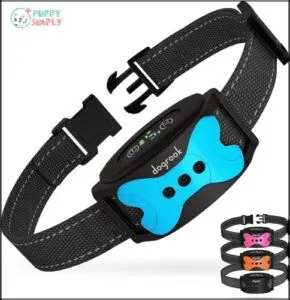
When barking turns your peaceful home into chaos, the Rechargeable Smart Dog Bark Collar steps in as the hero you didn’t know you needed.
This no-shock device uses gentle beeps and vibrations to guide your pup. With seven sound levels and two vibration modes, finding the right setting is a breeze.
It fits snugly on small dogs, is fully waterproof, and boasts a 14-day battery life. Plus, its progressive correction guarantees effective training without overwhelming your furry friend.
Peace for everyone, finally!
Best For: Small to medium-sized dog owners looking for a humane and customizable bark control solution.
- Gentle and humane correction with vibration and sound.
- Long-lasting 14-day rechargeable battery.
- Fully waterproof and suitable for outdoor use.
- May not work effectively for dogs with high tolerance to vibration.
- Sensitive to loud external noises, which might trigger false corrections.
- Some reports of collar falling off or getting chewed.
Effective Training Techniques
Training your small dog takes patience, consistency, and the right techniques to guarantee their safety and well-being.
By staying calm, rewarding good behavior, and understanding your dog’s triggers, you can teach them to bark less without causing stress.
Positive Reinforcement Methods
Pairing a bark collar with positive reinforcement turns training into a game your dog loves.
It’s not just about stopping the barking—it’s helping your dog feel rewarded for good behavior.
Here’s how you can use reward systems for better results:
- Treat often when your pup quiets down, making the connection clear.
- Clicker training works wonders; pair the sound with praise and treats immediately.
- Ignore barking but celebrate calm moments with excitement in your voice.
- Redirect attention using a favorite toy to shift their focus.
- Use treat alternatives, like belly rubs or playtime, for variety.
These dog training methods encourage long-term behavior modification through kindness!
Consistency in Training Sessions
Consistency is key to getting the most out of your training sessions with the best bark collar.
Small dogs thrive on predictability, so stick to a steady daily schedule they can rely on. Keep sessions around 10-15 minutes to prevent mental fatigue. Use the same clear commands and gestures—your dog’s not a mind reader! Tracking progress in a notebook helps you spot changes and celebrate wins.
- Establish a routine: Train at the same time and place daily.
- Involve the family: Everyone uses the same commands for consistency.
- Reward smartly: Reinforce good behavior immediately.
- Celebrate small wins: Progress takes time—be patient.
Stay consistent, and you’ll see behavior improvements quicker than you think!
Identifying Barking Triggers
Sometimes, understanding your dog’s nonstop barking feels like solving a mystery.
Most excessive barking stems from unmet needs or specific environmental factors—a little detective work reveals the cause.
| Trigger Type | Common Signs | Dog Barking Solutions |
|---|---|---|
| Boredom | Repeated barking, digging | Mental toys, longer walks |
| Separation Anxiety | Whining, destructive behavior | Gradual desensitization, safe spaces |
| Territorial Barking | Barking at passersby, guarding windows | Closed blinds, controlled exposure |
| Attention-Seeking | Stops barking when acknowledged | Reward silence, ignore barking |
| Medical Conditions | Unexplained barking/symptoms | Veterinarian checkup |
Your dog uses barking for communication, not rebellion.
Pair smart collars with dog behavior modification to target triggers like fear or separation anxiety.
Addressing root issues alongside training makes bark collars far more effective and guarantees long-term success.
To help curb excessive barking, consider positive reinforcement training.
Bark Collar Features
When choosing a bark collar for your small dog, it’s all about finding the right features for safe and effective training.
Look for adjustable sensitivity, accurate bark detection, and multiple training modes to guarantee a comfortable fit and stress-free experience.
Adjustable Sensitivity Levels
Tuning the sensitivity levels of a bark collar is like finding the perfect balance for your small dog’s needs—it takes precision and patience.
Adjustable sensitivity increments help you match the collar to your pup’s barking thresholds, avoiding unnecessary corrections.
Here’s what to look for:
- Gradual adjustment with at least 5-7 sensitivity levels for better control.
- Technology that minimizes false triggers, so neighborhood noises or other dogs won’t activate the collar.
- Customization options to fit breed differences and varying temperaments, ensuring training feels just right.
An adjustable collar grows with your pet’s learning curve, making progress smoother and reducing confusion.
To reduce boredom-induced barking, consider engaging puzzle toys.
In bark collar reviews, models with these features stand out as the best for small dogs.
Bark Detection Technology
Choosing the right bark collar for small dogs means understanding how bark detection technology works to guarantee accuracy without false corrections.
Modern collars rely on Sensor Accuracy to distinguish your pet’s bark from background noise or other animals.
Here’s how it works:
- Noise Filtering blocks sounds like traffic or barking dogs nearby.
- Bark Recognition focuses on your dog’s unique vocal pattern and matches throat vibrations.
- Trigger Thresholds prevent accidental corrections by confirming multiple signals before activating.
These anti-bark devices have evolved, ensuring your small pup gets proper feedback only when true barking is detected—not innocent yawns or play growls.
You can research small bark collars for more product options.
Training Modes and Options
In the context of training modes on a bark collar for small dogs, you’ve got plenty of options to match your pup’s behavior.
Think of these as tools in your dog-training toolbox—each designed for specific needs:
- Progressive Correction – Gradually increases intensity, teaching dogs to respond calmly.
- Vibration Intensity – Gives gentle feedback, perfect for sensitive dogs or first-timers.
- Spray Duration – Citronella collars distract with precise, harmless mist bursts.
- Sound Customization – Uses tones to interrupt barking without physical corrections.
Many collars blend Remote Training and Automatic Modes for extra control over sensitivity levels, helping you stay consistent and in charge.
Some models offer enhanced features through adjustable vibration settings.
Small Dog Breeds Considerations
When choosing a bark collar for small dogs, you’ve got to take into account their unique size and sensitivity.
The right collar should be lightweight, fit comfortably, and provide gentle, adjustable correction to guarantee your furry friend’s safety and comfort.
Success Rates for Different Breeds
Finding the best bark collar for your small dog depends on understanding how different breeds respond to various features.
Breed temperament plays a big role in collar effectiveness. Terriers, for example, are known to respond exceptionally well to static correction models, with success rates hitting 99%.
On the other hand, sensitive small dogs like Chihuahuas or Maltese may need gentler options, such as vibration or ultrasonic collars, to guarantee safe and effective training.
Companion breeds often do better with citronella collars, which have about 75% success rates.
Training consistency matters most—whatever you choose, pair it with patience and positive reinforcement methods for results that stick.
Long-term Behavior Modification
Creating lasting change in your small dog’s behavior takes consistent training and patience.
While bark collars can jumpstart progress, pairing them with dog training techniques builds stronger results. Think of it as teaching your dog a new routine, one rewarding silence over barking.
- Focus on trigger management: Identify what sets your dog off—doorbells, strangers, or squirrels—and work on desensitization.
- Use positive association: Reward quiet moments with praise or treats—your dog will soon connect calmness with good things.
- Practice gradual weaning: Limit collar reliance over time, allowing your dog’s new habits to stick.
Stay consistent for 4-6 weeks. Success comes through small, steady steps in dog behavior modification. Employing positive reinforcement techniques can greatly improve outcomes.
Comparing Collar Types
Not all bark collars are created equal, and finding the best bark collar for your small dog depends on their personality and habits.
The correction method is your starting point. For stubborn behavior, static collars can work, but they might be too harsh for nervous dogs. In that case, a vibration or ultrasonic bark collar might suit better. Citronella collars create short bursts of scent many dogs dislike, providing a gentler alternative.
Think about convenience too—remote vs automatic collars offer different levels of control during training. Lightweight materials and adjustable straps reduce irritation, especially for tiny breeds.
Here’s a quick comparison to help:
| Type | Correction Style | Best For | Drawbacks |
|---|---|---|---|
| Shock vs Vibration | Strong vs Gentle | Stubborn vs Sensitive Dogs | Stress vs Mild Effectiveness |
| Citronella vs Ultrasonic | Scent vs High-Pitched Noise | Gentle Deterrents | Frequent Refills vs Sound Sensitivity |
| Remote vs Automatic | Manual vs Self-Correcting | Hands-On Training vs Passive | Requires Attention vs Less Control |
| Progressive Correction | Gradual Escalation | Learning Types | May Take Time |
Choose what keeps your dog safe while maintaining comfort.
Ensuring Safe Use
You want your small dog to stay happy and safe while using a bark collar, so it’s important to choose the right one.
It’s crucial to adjust it properly, keeping an eye on their behavior, and remember that a comfortable fit and the correct settings make all the difference.
Choosing Right Collar for Small Dog
When choosing the right collar for your small dog, it’s all about safety, comfort, and effectiveness. Lightweight bark collars with soft, skin-friendly materials are essential for small breeds with sensitive necks or delicate fur. Aim for a snug fit without causing discomfort—neck comfort matters!
- Choose a training collar made with durable and lightweight materials for active small dogs.
- Prioritize adjustable features to match your dog’s unique size and breed sensitivity.
- Opt for gentle corrections like vibration or sound, avoiding harsh static shocks.
- Check for safety features like auto shut-offs and waterproof designs for outdoor play.
For humane training, consider collars that utilize vibration and buzzing to interrupt unwanted behavior. Remember, the best bark collar should support happy, stress-free training for your little companion.
Adjusting Sensitivity Levels
Adjusting the sensitivity levels on bark collars for small dogs is like fine-tuning a radio—you want clear results without unnecessary noise. Start with the lowest Bark Threshold to avoid overwhelming your pup.
Here’s how to get it right:
- Begin with minimal intensity; gradually increase based on your dog’s reaction (Gradual Increase is key).
- Keep an eye out for False Triggers—loud noises or other dogs might confuse the collar’s bark detection.
- Consider Breed Specificity and Temperament Impact, as smaller, sensitive breeds need a gentler approach.
- Fine-tune the settings for different bark types, whether it’s playful yapping or anxious barks.
Training takes time, so be patient. Small steps guarantee success without stressing your dog or triggering unnecessary corrections!
Monitoring Dog Progress
After adjusting the settings on your bark collar, focus on tracking your dog’s progress.
Watch for barking reduction, signs of stress, and behavioral changes. Keep a log of barking episodes, noting any comfort improvement with the dog training device.
Use observations to check collar effectiveness and training consistency. Small dogs may take a few weeks to adapt, so be patient.
Remember, the best bark collar doesn’t silence all barking—it helps manage it. Celebrate subtle wins, like less barking at the mailman, and note the overall progress.
Alternatives to Bark Collars
If a bark collar isn’t the right fit for your dog, there are plenty of safe alternatives to explore.
From positive reinforcement training to citronella sprays and ultrasonic devices, you’ve got options that suit both your dog’s needs and your peace of mind.
Positive Reinforcement Training
After safely setting up a bark collar, consider training methods that won’t require it at all.
Positive reinforcement training offers a gentler approach that builds lasting results through rewards rather than corrections.
When your small dog stays quiet in situations that typically trigger barking, reward them immediately with treats, praise, or play.
This creates a powerful connection between silence and good things happening.
- Clicker training marks the exact moment of quiet behavior, making learning crystal clear for your pup
- Redirecting behavior teaches your dog alternative responses to barking triggers
- Consistent commands help your dog understand exactly what you’re asking for
Remember, the best bark collar might be no collar at all, and using positive reinforcement can lead to more effective and longer-lasting results, making it a key part of gentle training methods.
Citronella Collars and Ultrasonic Devices
After teaching positive behaviors, you’ll find gentler options for immediate bark control that don’t involve shocks. Citronella collars and ultrasonic devices offer humane alternatives specifically designed for your small dog’s sensitive nature.
Citronella collars emit a plant-based spray when your pup barks, creating an unpleasant (but harmless) sensation that discourages the behavior. With spray effectiveness rates of up to 85%, they’ve outperformed electric options in multiple studies since their introduction in 1995.
Ultrasonic bark collars produce high-frequency sounds only dogs can hear, making them ideal for apartments where noise control matters.
Consider these popular options:
- Lightweight citronella collars requiring monthly refills
- Ultrasonic devices with adjustable sound frequency ranges (20,000-30,000 Hz)
- Combination anti-bark devices offering both spray and sound correction
These no-bark collar alternatives work wonderfully for tiny breeds under 15 pounds, with citronella options showing particularly strong results for Yorkies and Chihuahuas.
Other Non-Collar Training Methods
Beyond collars, you’ll find plenty of effective ways to address your small dog’s excessive barking.
Clicker training creates a clear communication system that dogs quickly understand.
| Method | How It Works | Best For |
|---|---|---|
| Clicker Training | Marks good behavior with a click followed by rewards | Quick learners |
| Desensitization Methods | Gradually exposes dog to triggers while teaching calm | Anxiety barkers |
| Environmental Enrichment | Provides mental stimulation through toys and activities | Boredom barkers |
| Redirected Behavior | Teaches alternative responses to barking triggers | Alert barkers |
Puzzle toys keep your pup’s mind occupied when you’re away, while strategic furniture arrangement can block window access to reduce territorial barking.
Remember, dog communication isn’t just vocal—understanding your pet’s body language helps you address problems before they become noisy situations.
Frequently Asked Questions (FAQs)
What is the best Barking collar for small dogs?
With an 85% effectiveness rate, the Petdiary B330 is your best bet for small pups.
It’s specially designed to fit necks as small as five inches, making it comfortable and effective for your little barker.
What is a bark collar?
A bark collar is a training device you wear around your dog’s neck that discourages excessive barking through various correction methods like sound, vibration, spray, or static stimulation.
It detects your dog’s bark through special sensors.
How effective is a dog bark collar?
The proof is in the pudding regarding bark collars. You’ll typically see 70-90% success rates when used properly, but they’re not one-size-fits-all solutions and may cause stress in some dogs.
Are Authen Bark collars safe for small dogs?
You can safely use Authen Bark collars on small dogs weighing 6+ pounds.
They’re lightweight (15 lbs), have adjustable sensitivity levels, and include safety features like "no harm" shock options and beep/vibration alternatives for gentle training.
The collars also offer gentle training methods, which is an important consideration for pet owners.
How big is a small dog bark collar?
Small dog bark collars typically weigh between 8-6 ounces and fit necks as small as 5 inches. You’ll want to choose a lightweight model under 3 ounces for your tiny pup’s comfort.
Does the PetSafe bark collar fit a small dog?
Yes, the PetSafe bark collar can fit a small dog, with adjustable straps designed for comfort.
It suits neck sizes as small as 6 inches, offering sound, vibration, or spray correction options depending on the model.
Do bark collars work on small dogs?
Imagine this: your little dog barking like a tiny tornado.
Bark collars can work if they’re lightweight, adjustable, and safe for small necks.
Go for vibration or sound modes—they’re gentler and still effective!
What do vets recommend to stop dogs from barking?
Vets often recommend positive reinforcement training, using treats or praise to reward quiet behavior.
For quick solutions, they suggest vibration or citronella collars as humane options, but always combine with training for long-term effectiveness.
What is the best device to stop small dogs barking?
Try the Petdiary B330, perfect for small dogs with necks as tiny as five inches.
It combines smart bark detection with sound and vibration correction, avoiding shocks while prioritizing safety and comfort.
Do vets recommend anti bark collars?
When tackling endless barking, think of anti-bark collars as a double-edged sword.
Many vets suggest positive reinforcement first, as collars, though effective, can cause stress.
If used, start gently, prioritizing your pup’s safety.
Conclusion
Finding the best bark collar for small dogs is like striking gold—it can transform your home’s peace and your pup’s behavior.
Choose a lightweight, adjustable option that suits your tiny dog’s needs, and remember, safety matters.
Gradually introduce the collar, monitor its use, and combine it with positive reinforcement training for lasting results.
With the right collar and consistent training, you’ll help your furry friend thrive while keeping barking at bay. Patience and care always win!
- https://www.humanesociety.org/resources/positive-reinforcement-training
- https://pubmed.ncbi.nlm.nih.gov/33326450/
- https://www.sciencedirect.com/science/article/abs/pii/S016815910300248X
- https://www.lcsupply.com/products/garmin-bark-limiter-deluxe?srsltid=AfmBOop_2qqPrD7Gy7Hrf1kB4i60r-lvU1PTEyRfbWJLzNHYGMlXNxCu
- https://www.hallmarkk9.com/garminbarklimiterdeluxe.aspx



